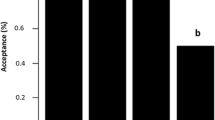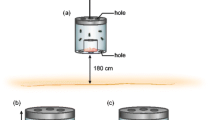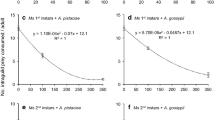Abstract
Predation is a major process in determining the composition and dynamics of necrophagous dipteran assemblages and has implications for the colonization of cadavers. This work describes behavioural interactions between necrophagous larvae under a predator-prey perspective, using as a model the predatory species Chrysomya albiceps (Wiedemann) (Diptera: Calliphoridae) and three species of prey: Lucilia eximia (Wiedemann) (Calliphoridae), Synthesiomyia nudiseta (Wulp) (Muscidae) and Peckia (Peckia) chrysostoma (Wiedemann) (Sarcophagidae). Using experimental arenas, we observed behavioural acts, such as escape, avoidance and prey discrimination in three experiments, which also incorporated predator density. We demonstrate that the number of escapes, avoidance and predation varies according to the type of prey. Lucilia eximia and P. chrysostoma are able to avoid and/or escape the predator more frequently when compared to S. nudiseta. At least 70% of larvae of both species successfully evaded from C. albiceps attack. Low frequency of escape, associated with strong ability to counterattack, was observed for S. nudiseta. Peckia chrysostoma and L. eximia were the preferred items in the experiment of prey discrimination in both 2- and 3-choice tests. Predation occurs quickly, and the minimum predation time varied according to the prey species and predator density. Remarkably, prey handling varied with the species: whilst individual larvae chased and killed L. eximia, 75% of predation of P. chrysostoma occurred in groups of two or more C. albiceps larvae. Differential intraguild predation has implications for reducing populations of carrion insects—consequently affecting the likelihood of sampling necrophagous larvae in human cadavers.




Similar content being viewed by others
References
Andrade HTA, Varela-Freire AA, Batista MJA, Medeiros JF (2005) Calliphoridae (Diptera) coletados em cadáveres humanos no Rio Grande do Norte. Neotrop Entomol 34:855–856
Baumgartner DL (1993) Review of Chrysomya rufifacies (Diptera: Calliphoridae). J Med Entomol 30:338–352
Benbow ME, Lewis AJ, Tomberlin JK, Pechal JL (2013) Seasonal necrophagous insect community assembly during vertebrate carrion decomposition. J Med Entomol 50:440–450
Carmo RFR, Vasconcelos SD, Brundage AL, Tomberlin JK (2018) How do invasive species affect native species? Experimental evidence from a carrion blowfly (Diptera: Calliphoridae) system. Ecol Entomol 43:483–493
Carvalho CJB, Mello-Patiu CA (2008) Key to the adults of the most common forensic species of Diptera in South America. Rev Brasil Entomol 52:390–406
Charnov EL (1976) Optimal foraging, the marginal value theorem. Theo Pop Bio 9:129–136
Denno RF, Cothran WR (1976) Competitive interactions and ecological strategies of Sarcophagid and Calliphorid flies inhabiting rabbit carrion. Ann Entomol Soc Am 69:109–113
Faria LDB, Orsi L, Trinca LA, Godoy WAC (1999) Larval predation by Chrysomya albiceps on Cochliomyia macellaria, Chrysomya megacephala and Chrysomya putoria. Entomol Exp Appl 90:149–155
Faria LDB, Godoy WAC, Reis SF (2004) Larval predation on different instars in blowfly populations. Braz Arch Biol Tech 47:887–894
Faria LS, Paseto ML, Couri MS, Mello-Patiu CA, Mendes J (2018) Insects associated with pig carrion in two environments of the Brazilian savannah. Neotrop Entomol 47:181–198
Fouche Q, Hedouin V, Charabidze D (2018) Communication in necrophagous Diptera larvae: interspecific effect of cues left behind by maggots and implications in their aggregation. Sci Rep 8:2844. https://doi.org/10.1038/s41598-018-21316-x
Galindo LA, Moral RA, Moretti TC, Godoy WAC, Demétrio CGB (2016) Intraguild predation influences oviposition behaviour of blow flies (Diptera: Calliphoridae). Parasitol Res 115:2079–2012
Gião JZ, Godoy WAC (2007) Ovipositional behaviour in predator and prey blowflies. J Insect Behav 20:77–86
Grzywacz A, Hall MJR, Pape T, Szpila K (2017) Muscidae (Diptera) of forensic importance - an identification key to third instar larvae of the western Palaearctic region and a catalogue of the muscid carrion community. Int J Legal Med 131:855–866
Ivorra T, Martínez-Sánchez A, Rojo S (2019) Predatory behaviour of Synthesiomyia nudiseta larvae (Diptera: Muscidae) on several necrophagous blowfly species (Diptera: Calliphoridae). Int J Legal Med 133:651–660
Lo Pinto S, Giordai G, Tuccia F, Ventura F, Vanin S (2017) First records of Synthesiomyia nudiseta (Diptera: Muscidae) from forensic cases in Italy. Forensic Sci Int 276:e1–e7. https://doi.org/10.1016/j.forsciint.2017.05.003
Meira LMR, Barbosa TM, Jales JT, Santos AN, Gama RA (2020) Insects associated to crime scenes in the northeast of Brazil: consolidation of collaboration between entomologists and criminal investigation institutes. J Med Entomol 57:1012–1020
Payne JA (1965) A summer carrion study of the baby pig Sus scrofa Linnaeus. Ecology 46:592–602
Prado e Castro C, Serrano A, Martins da Silva P, García MD (2012) Carrion flies of forensic interest: a study of seasonal community composition and succession in Lisbon, Portugal. Med Vet Entomol 26:417–431
Reigada C, Godoy WAC (2005) Seasonal fecundity and body size in Chrysomya megacephala (Fabricius) (Diptera: Calliphoridae). Neotrop Entomol 34:163–168
Reis SF, Von Zuben CJ, Godoy WAC (1999) Larval aggregation and competition for food in experimental populations of Chrysomya putoria (Wied.) and Cochliomyia macellaria (F.) (Dipt. Calliphoridae). J Appl Entomol 123:485–489
Renou M (2014) Pheromones and general odor perception in insects. In: Mucignat-Caretta C (ed) Neurobiology of chemical communication. CRC Press/Taylor and Francis, Boca Raton
Rosa TA, Batata ML, Souza CM, Sousa D, Mello-Patiu CA, Mendes J (2009) Dípteros de interesse forense em dois perfis de vegetação de Cerrado em Uberlândia, MG. Neotrop Entomol 38:859–866
Sanford MR (2017) Insects and associated arthropods analyzed during medicolegal death investigations in Harris County, Texas, USA: January 2013 - April 2016. PLoS One 12:e0179404. https://doi.org/10.1371/journal.pone.0179404
Shiao S, Yeh T (2008) Larval competition of Chrysomya megacephala and Chrysomya rufifacies (Diptera: Calliphoridae): behaviour and ecological studies of two blow fly species of forensic significance. J Med Entomol 45:785–799
Smith KGV (1986) A manual of forensic entomology. British Museum (Natural History), London, and Cornell University Press, Ithaca, New York
So P, Dudgeon D (1990) Interspecific competition among larvae of Hemipyrellia ligurriens (Calliphoridae) and Boettcherisca formosensis (Sarcophagidae) (Diptera). Res Popul Ecol 32:337–348
Stephens DW, Krebs JR (1986) Foraging theory. Princeton University Press, Princeton
Thyssen PJ (2010) Keys for identification of immature insects. In: Amendt J, Campobasso CP, Grassberger M, Goff ML (Org.). Forensic entomology: novel arthropods, environments and approaches. Amsterdan: Springer p. 10-36
Tomberlin JK, Barton BT, Lashley MA, Jordan HR (2017) Mass mortality events and the role of necrophagous invertebrates. Insect Sci 23:7–12
VanLaerhoven SL (2015) Modeling species interactions within carrion food webs. In: Benbow ME, Tomberlin JK, Tarone AM (eds) Carrion ecology, evolution, and their applications. CRC Press, Taylor and Francis Group, pp. 231–246
Vasconcelos SD, Cruz TM, Salgado RL, Thyssen PJ (2013) Dipterans associated with decomposing animal carcass in a rainforest fragment in Brazil: notes on the early arrival and colonization by necrophagous species. J Insect Sci 13:145–111. https://doi.org/10.1673/031.013.14501
Vasconcelos SD, Soares TF, Costa DL (2014) Multiple colonization of a cadaver by insects in an indoor environment: first record of Fannia trimaculata (Diptera: Fanniidae) and Peckia (Peckia) chrysostoma (Sarcophagidae) as colonizers of a human corpse. Int J Legal Med 128:229–233
Wells JD, Greenberg B (1992) Rates of predatory by Chrysomya rufifacies (Macquart) on Cochliomyia macellaria (Fabr.) (Diptera: Calliphoridae) in the laboratory: effect of predator and prey development. Pan-Pac Entomol 68:12–14
Wells JD, Kurahashi H (1997)Chrysomya megacephala (Fabr.) is more resistant to attack by Ch. rufifacies (Macquart) in a laboratory arena than is Cochliomyia macellaria (Fabr.) (Diptera: Calliphoridae). Pan-Pac Entomol 73:16–20
Acknowledgements
We thank the Coordenação de Aperfeiçoamento de Pessoal de Nível Superior (CAPES) for the scholarships granted to JTJ (PhD) and TMB (PNPD), and Larissa Martins for the support in the behavioural experiments.
Contribution of Authors
Conceived and designed the project: TMB. Collected field samples: TMB, JTJ, JRM. Performed the lab work and analysed the data: TMB, JTJ, JRM, SDV. Wrote the paper: TMB, JTJ, JRM, SDV, RAG. All authors read and approved the final version of the manuscript.
Author information
Authors and Affiliations
Corresponding author
Additional information
Edited by Patrícia J Thyssen
Publisher’s Note
Springer Nature remains neutral with regard to jurisdictional claims in published maps and institutional affiliations.
Supplementary Information
Videos 1
- Demonstration of searching behaviour – predatory Chrysomya albiceps searching and preying upon larvae in other quadrants. (MP4 5744 kb)
Videos 2
- Synthesiomyia nudiseta larvae reacting and trying to avoid Chrysomya albiceps attack. (MP4 1445 kb)
Video 3
- Record of Peckia chrysostoma larvae being preyed upon by Chrysomya albiceps larvae (group predations) and prey larvae evasion. (MP4 2881 kb)
Rights and permissions
About this article
Cite this article
Barbosa, T.M., Jales, J.T., Medeiros, J.R. et al. Behavioural Aspects of the Prey-Predator Interaction Among Necrophagous Diptera: Implications for Cadaveric Colonization. Neotrop Entomol 50, 303–311 (2021). https://doi.org/10.1007/s13744-020-00837-z
Received:
Accepted:
Published:
Issue Date:
DOI: https://doi.org/10.1007/s13744-020-00837-z




